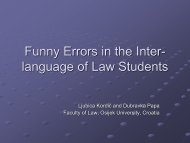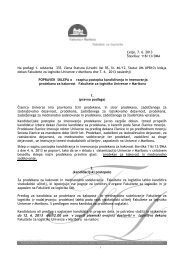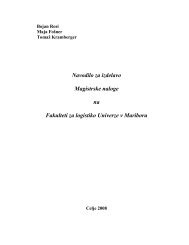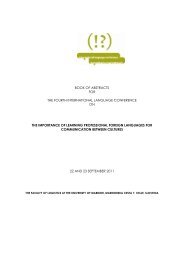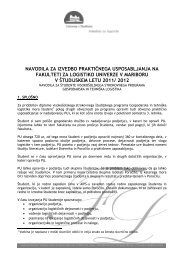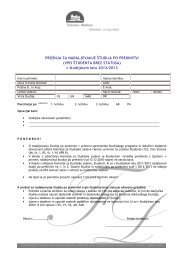Active Listening and Assertive Communication Style in LSP Teaching
Active Listening and Assertive Communication Style in LSP Teaching
Active Listening and Assertive Communication Style in LSP Teaching
- No tags were found...
You also want an ePaper? Increase the reach of your titles
YUMPU automatically turns print PDFs into web optimized ePapers that Google loves.
<strong>Active</strong> <strong>Listen<strong>in</strong>g</strong> <strong>and</strong> <strong>Assertive</strong><strong>Communication</strong> <strong>Style</strong> <strong>in</strong> <strong>LSP</strong>Teach<strong>in</strong>gKsenija JURETIĆ <strong>and</strong> Krist<strong>in</strong>a KAŠTELANUniversity of Rijeka, Faculty ofEconomics, Rijeka, Croatia
<strong>Active</strong> <strong>Listen<strong>in</strong>g</strong> <strong>and</strong> <strong>Assertive</strong>• Multitask<strong>in</strong>g<strong>Communication</strong> <strong>Style</strong>…• Noisy <strong>Communication</strong> Channels & Cont<strong>in</strong>uousPartial Attention (CPA)• Four <strong>Communication</strong> <strong>Style</strong>s• <strong>Active</strong> <strong>Listen<strong>in</strong>g</strong> <strong>and</strong> <strong>Assertive</strong>ness• Research Results• Conclusion
Multitask<strong>in</strong>g vs. Cont<strong>in</strong>uous PartialAttention (CPA)• In comput<strong>in</strong>g, multitask<strong>in</strong>g is a method wheremultiple tasks are performed dur<strong>in</strong>g the sameperiod of time. (Multimedia - a classic example ofmultitask<strong>in</strong>g that converges images, video, <strong>and</strong> sound)• Simple multitask<strong>in</strong>g• Complex Multitask<strong>in</strong>g- CPA (L<strong>in</strong>da Stone,1997)
Cont<strong>in</strong>uous Partial Attention (CPA)• Complex multitask<strong>in</strong>g: People are hyper alert with thepace 24/7, anywhere, anytime, anyplace struggl<strong>in</strong>g with theirworkload ask<strong>in</strong>g their bra<strong>in</strong>s to attend to 4 I.M. conversations,a partially completed paper, a news website, a text messagecom<strong>in</strong>g <strong>in</strong> on the cell phone <strong>and</strong> a conversation with theperson sitt<strong>in</strong>g next to them us<strong>in</strong>g CPA as their primaryattention strategy( L<strong>in</strong>da Stone, 1997, 2010)• Complex multitask<strong>in</strong>g = CPA ( e-mail / screenapnea) compromised breath<strong>in</strong>g +compromisedattention
Digital immigrants vs. Digitalnatives• Digital immigrants (prior to 1990s) - personalcomput<strong>in</strong>g technologies ( focus on productivity <strong>and</strong> personalcreativity ; a value on self-expression, output <strong>and</strong> efficiency)• Digital natives - the personal communicationstechnology era ( focus is on the amplified accessibility <strong>and</strong>responsiveness): comb<strong>in</strong>e ‘old media’ such as TV <strong>and</strong> music with ‘new media’ suchas computers, smart phones, <strong>and</strong> cont<strong>in</strong>ually <strong>in</strong>crease sources of <strong>in</strong>put - they goonl<strong>in</strong>e while watch<strong>in</strong>g TV, talk on the phone, listen to music, surf the Web, useFacebook/ Twitter while text-messag<strong>in</strong>g <strong>and</strong> study<strong>in</strong>g.
Noisy <strong>Communication</strong> ChannelsDigital Immigrants are faced with• Environmental Noise (physically disrupts communication:st<strong>and</strong><strong>in</strong>g next to loud speakers, works at a construction site mak<strong>in</strong>g itdifficult to hear the speaker)• Semantic Noise (mis<strong>in</strong>terpretation of the mean<strong>in</strong>gs of certa<strong>in</strong> wordstaken out of the context)• Syntactical Noise (mistakes <strong>in</strong> grammar)• Cultural Noise (stereotypical assumptions )• Organisational Noise (poorly structured messages )• Psychological Noise ( anger, sadness or anxiety that may causesomeone to lose focus on the message itself)
The Noisy <strong>Communication</strong> Channels DigitalNatives are faced with:• Cont<strong>in</strong>uous PartialAttention• The consequences are apart fromstress-related diseases(compromised breath<strong>in</strong>g <strong>and</strong>compromised attention),cont<strong>in</strong>uous distractions that cancause anxiety, lack of activelisten<strong>in</strong>g <strong>and</strong> non-assertivecommunication.• Hypothesis as a start<strong>in</strong>gpo<strong>in</strong>t:• The paradox is the louder theenvironmental, semantic,cultural <strong>and</strong> psychological noise<strong>in</strong> communication channels, thelouder the “sound of silence”.• And <strong>in</strong> the naked light I sawTen thous<strong>and</strong> people, maybe more.People talk<strong>in</strong>g without speak<strong>in</strong>g,People hear<strong>in</strong>g without listen<strong>in</strong>g,People writ<strong>in</strong>g songs that voicesnever shareAnd no one daredDisturb the sound of silence.• ( Simon &Garfunkel lyrics, 1964)
<strong>Communication</strong> <strong>Style</strong>sPassivePassiveaggressiveAggressive• passive communicators(whose ‘voices nevershare’) do not defend theirpersonal boundaries• ‘’<strong>in</strong>dividuals appear passiveon the surface but are reallyact<strong>in</strong>g out anger <strong>in</strong> a subtle,<strong>in</strong>direct, or beh<strong>in</strong>d-thescenesway• does not respect the personalboundaries of others <strong>and</strong> thusoften harms others while try<strong>in</strong>gto <strong>in</strong>fluence them , often be<strong>in</strong>gverbally <strong>and</strong>/or physicallyabusive (‘<strong>and</strong> no one daredisturb the sounds of silence’).
<strong>Active</strong> <strong>Listen<strong>in</strong>g</strong> <strong>and</strong> <strong>Assertive</strong><strong>Communication</strong> <strong>Style</strong><strong>Active</strong> <strong>Listen<strong>in</strong>g</strong><strong>Assertive</strong>nesstotal <strong>and</strong>undividedattention<strong>in</strong>terest<strong>and</strong>concernlisten notonly withour ears,but withour eyes,m<strong>in</strong>d, heart<strong>and</strong>imag<strong>in</strong>ationto absorbeveryth<strong>in</strong>g thespeaker issay<strong>in</strong>g verbally<strong>and</strong>nonverballywithoutadd<strong>in</strong>g,subtract<strong>in</strong>g, oramend<strong>in</strong>g.”(Carl Rogers,1980)a person couldnot be bothassertive <strong>and</strong>anxious at thesame time,<strong>and</strong> thus be<strong>in</strong>gassertivewould <strong>in</strong>hibitanxiety(Joseph Wolpe,1958)<strong>Assertive</strong>communicatorshave high selfesteem,whilebe<strong>in</strong>g veryrespectful of therights of others.'I count myneeds. I countyour needs'position"
5 As + S IN EFFECTIVECOMMUNICATION• PAYATTENTIONATTENTIONAPPRECIATION• APPRECIATEDIFFERENCES• LISTENVERBALLY ANDNON VERBALLYACTIVELISTENING• YES AND NOIN THE SAMEPOLITE WAYASSERTIVENESSARGUMENTATION• FOR ANDAGAINSTARGUMENTS• In harmonywith onself<strong>and</strong> othersSUCCESS
ResearchSample <strong>and</strong> Methodsexperimental group (50)- third year studentscontrol group (60) – first year students
• The test consists of two parts:• The first part – a reflective listen<strong>in</strong>g skills test with 10questions offer<strong>in</strong>g two possible response alternatives• The second comprised of 28 particles onmultitask<strong>in</strong>g, active listen<strong>in</strong>g skills <strong>and</strong> CPA whichwere evaluated on the 5- likert scale. The data of thesurvey was analyzed by means of descriptivestatistics, specifically the t-test analysis.
Figure 1: Percentage of students accord<strong>in</strong>g to the total achieved value classClass 1st year 3rd year15-20 17,39% 26,32%10-15 63,77% 57,89%5-10 14,49% 15,79%0-5 4,35% 0,00%
• The t-tests analyze the degree of respondent’s activelisten<strong>in</strong>g skills accord<strong>in</strong>g to <strong>in</strong>dividual particles <strong>in</strong> thequestionnaire based on the respondent’s belief (seeTables <strong>in</strong> Appendix 2)• Even though, while observ<strong>in</strong>g the total mean for allparticles there is a slight difference <strong>in</strong> the averagemean of the control <strong>and</strong> experimental group (3. 36<strong>and</strong> 3.55 respectively), the statistical analysis provesseveral statistically significant differences betweenfirst <strong>and</strong> third year students regard<strong>in</strong>g theirbehaviour while listen<strong>in</strong>g to the speaker.
• The third year students had better results <strong>in</strong>active listen<strong>in</strong>g as they:• more commonly make eye contact nod theirheads <strong>in</strong> agreement while listen<strong>in</strong>g to the speaker.• more frequently give their full attention to thespeaker <strong>and</strong> the speaker’s body language• have more patience <strong>in</strong> wait<strong>in</strong>g for the speaker tof<strong>in</strong>ish before mak<strong>in</strong>g mental judgments <strong>and</strong> arenot prone to <strong>in</strong>terrupt<strong>in</strong>g a serious discussion <strong>in</strong>order to make a personal call• For more detailed statistical analysis data, see tables <strong>in</strong> Appendix 2.
• the descriptive statistical t-test analysis accord<strong>in</strong>gto gender showed no statistically significantdifferences for the first year students <strong>and</strong> onlytwo significant differences among the third yearresults.• The third year female students more frequentlyf<strong>in</strong>d themselves th<strong>in</strong>k<strong>in</strong>g about what they arego<strong>in</strong>g to say whereas the male students pay closerattention to the speaker’s body language whenlisten<strong>in</strong>g to the speaker
Mean 3rd Mean 1st t-value df p Valid N Valid N Std.Dev. Std.Dev. F-ratio1 3.953488 3.550725 1.96056 110 0.052459 43 69 1.090074 1.036627 1.1057762 3.604651 3.666667 -0.28962 110 0.772655 43 69 0.979298 1.171558 1.4311913 3.372093 3.246377 0.61730 110 0.538310 43 69 0.900351 1.129885 1.5748734 4.116279 3.579710 2.26710 110 0.025339 43 69 1.051287 1.310655 1.5542985 4.023256 3.391304 2.82898 110 0.005551 43 69 1.123099 1.165905 1.0776826 3.418605 3.086957 1.90907 110 0.058858 43 69 0.879192 0.903248 1.0554717 2.813953 3.188406 -1.86825 110 0.064389 43 69 1.006072 1.047060 1.0831408 3.372093 3.579710 -1.01113 110 0.314173 43 69 0.951772 1.116794 1.3768319 3.837209 3.231884 2.61495 110 0.010175 43 69 1.044948 1.273542 1.48538010 3.883721 3.507246 1.56022 110 0.121581 43 69 1.117167 1.313092 1.38151111 3.186047 3.231884 -0.22702 110 0.820833 43 69 1.139252 0.972337 1.37279712 3.000000 3.115942 -0.55522 110 0.579875 43 69 0.899735 1.169920 1.69076313 3.511628 3.304348 0.97630 110 0.331057 43 69 1.054968 1.115458 1.11796414 4.139535 3.797101 1.49775 110 0.137061 43 69 0.940653 1.301353 1.91395415 3.279070 3.246377 0.18063 110 0.856993 43 69 0.983811 0.897804 1.20077116 3.860465 3.246377 3.05199 110 0.002850 43 69 0.888589 1.116794 1.57959117 3.441860 3.579710 -0.62137 110 0.535640 43 69 1.097667 1.168279 1.13279718 3.441860 3.434783 0.03868 110 0.969214 43 69 0.958727 0.931132 1.06015019 3.395349 3.289855 0.57384 110 0.567244 43 69 0.694863 1.072400 2.38185420 3.837209 3.478261 1.64304 110 0.103229 43 69 1.044948 1.170830 1.25544821 3.930233 3.478261 2.00546 110 0.047369 43 69 1.032688 1.232032 1.42332922 3.906977 3.565217 1.63975 110 0.103915 43 69 0.995560 1.117748 1.26052823 3.162791 3.173913 -0.05731 110 0.954406 43 69 0.998337 0.999360 1.00205024 2.883721 2.985507 -0.46537 110 0.642587 43 69 1.117167 1.131017 1.02494825 3.953488 3.565217 1.90649 110 0.059196 43 69 0.998892 1.077555 1.16370326 3.325581 3.275362 0.23488 110 0.814738 43 69 1.128018 1.083079 1.08470627 3.116279 3.333333 -1.10838 110 0.270117 43 69 1.117167 0.934103 1.43036328 3.813953 3.043478 3.68512 110 0.000356 43 69 1.006072 1.117176 1.233061






